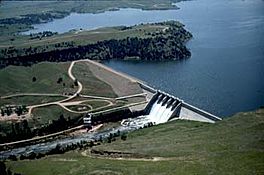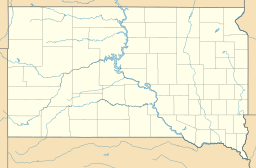Angostura Reservoir facts for kids
Quick facts for kids Angostura Reservoir |
|
|---|---|

Angostura Dam
|
|
| Location | Fall River County, South Dakota, United States. Near Hot Springs, South Dakota |
| Coordinates | 43°20′36″N 103°26′16″W / 43.34333°N 103.43778°W |
| Type | artificial lake |
| Primary inflows | Cheyenne River Dry Creek Horsehead Creek Tepeee Creek |
| Primary outflows | Cheyenne River |
| Basin countries | United States |
| Surface area | 4,407 acres (17.83 km2) |
| Max. depth | 75 ft (23 m) |
| Shore length1 | 42 mi (68 km) |
| Surface elevation | 3,127 ft (953 m) |
| 1 Shore length is not a well-defined measure. | |
Angostura Reservoir is a large, human-made lake in Fall River County, South Dakota, United States. It was created on the Cheyenne River in 1949. The name "Angostura" means "narrows" in Spanish. This reservoir helps farmers by providing water for their crops. It is also a very popular spot for outdoor fun and a home for many birds.
Contents
Discover Angostura Reservoir
Angostura Reservoir is an important part of South Dakota. It was built by the U.S. Bureau of Reclamation. They finished the Angostura Dam in 1949. The main reason for building it was for irrigation. This means providing water to help grow crops.
About the Lake
The reservoir covers a large area. It is about 4,407 acres (17.83 km2) big. The surface of the water is about 3,127 ft (953 m) above sea level. At its deepest point, the lake is about 75 ft (23 m) deep.
Fun Activities at the Lake
The area around Angostura Reservoir is called the Angostura Recreation Area. It is a great place for many outdoor activities.
- You can go boating on the lake.
- It's a popular spot for swimming.
- Many people enjoy camping nearby.
- Fishing is also a favorite activity here.
What Fish Live Here?
The lake is home to several types of fish. You might catch:
- Walleye
- Northern pike
- Smallmouth bass
- Different kinds of sunfish
Wildlife Around the Reservoir
Angostura Reservoir is one of the few large bodies of water in its area. This makes it a very important stop for migratory birds. These birds use the lake as a resting place. They stop here during their long journeys.



